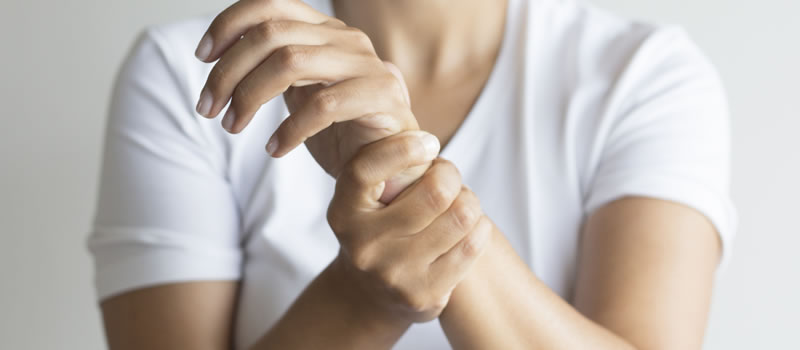How to Support Your Joints and Relieve Joint Pain
Published February 6, 2023

Why do my joints hurt so much?
Joint pain will affect most people at some point in their life. Some may experience pain around the joint — like bursitis or tendonitis — from a sprain or strain associated with sport or exercise; others may experience pain and inflammation in the joint itself. Several common medical conditions contribute to joint pain; these include:
- Osteoarthritis — Osteoarthritis (OA) is a degenerative disease with low-grade inflammation in the cartilage and connective tissue around the joint. This inflammation leads to the loss of joint structure and gradual deterioration of joint cartilage. Your likelihood of getting OA is influenced by your genes, gender, ethnicity and age, but obesity, poor diet, sedentary lifestyle and sports injuries can also contribute to the development of OA.
- Gout — Gout is a build-up of uric acid crystals in the joint causing pain, redness and swelling. Gout is usually associated with pain in a single joint.
Osteoarthritis is the most common form of joint pain in Australia, with an estimated 2.2 million Australians diagnosed. Osteoarthritis represents over half (62%) of all arthritic conditions with the prevalence increasing from the age of 45 years. 1 in 5 Australians over the age of 45 have osteoarthritis. Osteoarthritis is also more common among women than men, affecting 10% of women compared to 6.1% of men (after adjusting for age).
How can I help protect my joints?
Protecting your joints can help reduce the risk of joint injury and joint degeneration as you age, reducing the risk of developing osteoarthritis. There are several lifestyle changes you can make to help protect your joints:
Maintain a healthy weight
Carrying excess weight can put undue pressure on your joints – your knee joints in particular – and cause the cartilage to deteriorate more rapidly.
Regular, low-impact exercise
Physical activity helps to strengthen the muscles that support your joints, keeping them supple, flexible and improving joint alignment.
Prevent joint injury
Research has shown that in older adults, osteoarthritis develops faster after an acute joint injury. Protecting your joints at work and during exercise as you age can help prevent injury.
Eat a balanced diet
Eat a healthy diet rich in vegetables, good fats and protein. A healthy diet helps you maintain a healthy weight and also provides the antioxidants and micronutrients you need to protect your joints from oxidative damage as you age.
Take Glucosamine & Chondroiton
Supplements containing substances like glucosamine and chondroitin in combination may be beneficial in relieving mild joint pain.
Take a natural anti-inflammatory
Natural anti-inflammatories like Curcumin from turmeric have been shown to reduce mild pain and inflammation in joints.
Vitamins C & D
In a case-control study with 180 people with knee osteoarthritis, Vitamin C intake was 7% lower than controls and Vitamin D intake was almost 17% lower than controls for the women in the study. Eating foods rich in vitamin C like berries and vegetables and spending some time in the sun to boost vitamin D levels may help prevent joint pain.
Omega-3 fatty acids
Omega-3 fatty acids found in oily fish have been shown to have a beneficial effect on joint pain and function and might be associated with reducing structural damage in joints. Eating a diet rich in the beneficial omega-3 fats may help support your joints. Concentrated Omega-3 supplements are also available if your dietary intake is inadequate.
Avoid repetitive joint loading tasks
Some jobs may involve repetitive tasks such as squatting and bending that may be a risk factor for osteoarthritis. If you are concerned, try and vary your tasks throughout the day to reduce the risk.
How can I relieve joint pain at home?
Sore joints not only cause pain and discomfort but can also stop you doing activities you enjoy. Try these home remedies to help bring some relief:
1. Soak in an Epsom salt bath
Pour yourself a hot bath and feel those aches melt away. For extra pain relief, add a generous helping of Epsom salts – they contain magnesium sulphate, a mineral used for relieving the pain associated with swelling.
2. Get a massage
Massage is an age-old technique for reducing joint pain. For instant relief on-the-go, try massaging the back of the knees with a tennis ball: nestle the ball behind your knee joint while in an upright, seated position, then contract and relax your muscle against the ball. Complete one set of ten on each knee. You should consult with a physio first in order to avoid any excess pulling or stretching during massage.
3. Switch between hot and cold
Applying hot and cold packs to stiff, painful joints can work wonders – particularly when you alternate between the two. Heat is most effective if the discomfort is as a result of inactivity and is great for improving mobility and pain relief: try taking a long hot shower or applying a heat pack or pad on the problem area for up to 20 minutes at a time. Cold packs are also particularly good for pain relief — place a bag of ice or frozen vegetables wrapped in a towel on the affected area for no more than 20 minutes.
4. Get moving
Inactivity can lead to stiff muscles which may exacerbate knee pain, so it’s important to keep your joints active through regular exercise. Low-intensity exercise will not only help with joint flexibility and mobility but also strengthen and stretch the muscles that surround the knee joints. However, be mindful if certain types of exercise aggravate your knee pain and always ease back into your exercise routine after an injury. Speak to your healthcare practitioner for more information.
5. Rest and relaxation
Balancing regular exercise with adequate rest is essential for managing joint pain. Lack of sleep may contribute to inflammation in the body, so it’s important to get a good night’s sleep to give your body the time to repair itself naturally. Additionally, if you favour high-intensity workouts or strength training, make sure you allow time for rest and recover to avoid overusing joints and prevent potential injury.
Taking the time to protect your joints will help prevent future injury and potential joint degeneration. Maintaining a healthy weight, low impact exercise and eating a diet rich in good fats, antioxidants and anti-inflammatory foods will help support your joints, so they can keep supporting you.
MAT-AU-2100673
Learn about which Nature's Own product may be appropriate for you.
SEE THE PRODUCTS HERE







